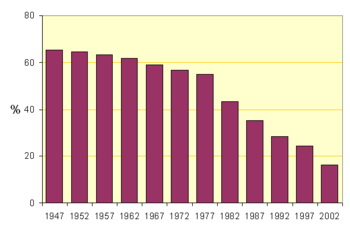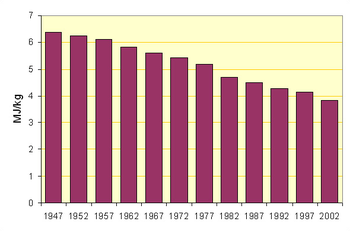
The rotary kiln consists of a tube made from steel plate, and lined with firebrick. The tube slopes slightly (1–4°) and slowly rotates on its axis at between 30 and 250 revolutions per hour. Rawmix is fed in at the upper end, and the rotation of the kiln causes it gradually to move downhill to the other end of the kiln. At the other end fuel, in the form of gas, oil, or pulverized solid fuel, is blown in through the "burner pipe", producing a large concentric flame in the lower part of the kiln tube. As material moves under the flame, it reaches its peak temperature, before dropping out of the kiln tube into the cooler. Air is drawn first through the cooler and then through the kiln for combustion of the fuel. In the cooler the air is heated by the cooling clinker, so that it may be 400 to 800 °C before it enters the kiln, thus causing intense and rapid combustion of the fuel.
The wet process and the dry process
From the earliest times, two different methods of rawmix preparation were used: the mineral components were either dry-ground to form a flour-like powder, or were wet-ground with added water to produce a fine slurry with the consistency of paint, and with a typical water content of 40–45%.

% of North American Capacity using Wet Process
The wet process suffered the obvious disadvantage that, when the slurry was introduced into the kiln, a large amount of extra fuel was used in evaporating the water. Furthermore, a larger kiln was needed for a given clinker output, because much of the kiln's length was used up for the drying process. On the other hand, the wet process had a number of advantages. Wet grinding of hard minerals is usually much more efficient than dry grinding. When slurry is dried in the kiln, it forms a granular crumble that is ideal for subsequent heating in the kiln. In the dry process, it is very difficult to keep the fine powder rawmix in the kiln, because the fast-flowing combustion gases tend to blow it back out again. It became a practice to spray water into dry kilns in order to "damp down" the dry mix, and thus, for many years there was little difference in efficiency between the two processes, and the overwhelming majority of kilns used the wet process. By 1950, a typical large, wet process kiln, fitted with drying-zone heat exchangers, was 3.3 x 120 m in size, made 680 tonnes per day, and used about 0.25–0.30 tonnes of coal fuel for every tonne of clinker produced. Before the energy crisis of the 1970s put an end to new wet-process installations, kilns as large as 5.8 x 225 m in size were making 3000 tonnes per day.

Mean Fuel Energy used in North American Rotary Kilns
An interesting footnote on the wet process history is that some manufacturers have in fact made very old wet process facilities profitable through the use of waste fuels. Plants that burn waste fuels enjoy a negative fuel cost (they are paid by industries needing to dispose of materials that have energy content and can be safely disposed of in the cement kiln thanks to its high temperatures and longer retention times). As a result the inefficiency of the wet process is an advantage—to the manufacturer. By locating waste burning operations at older wet process locations, higher fuel consumption actually equates to higher profits for the manufacturer, although it produces correspondingly greater emission of CO2. Manufacturers who think such emissions should be reduced are abandoning the use of wet process.